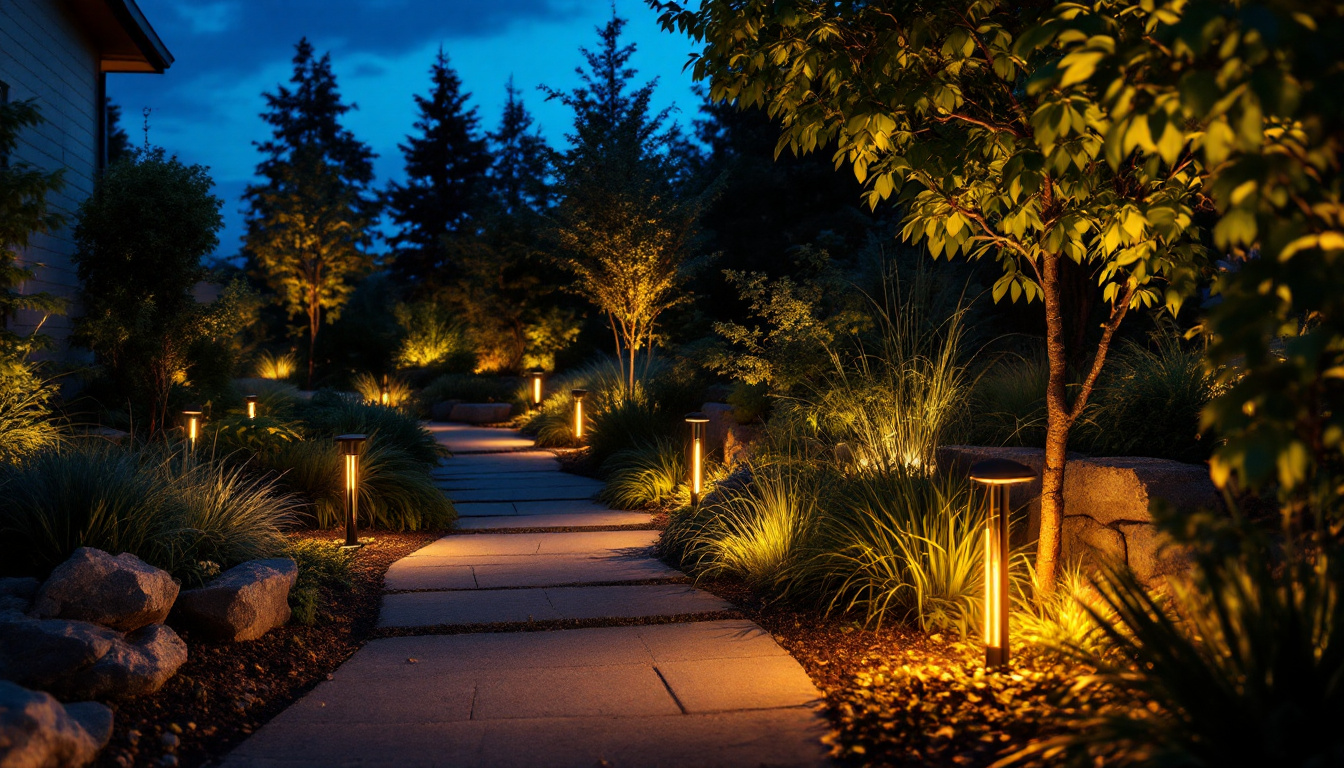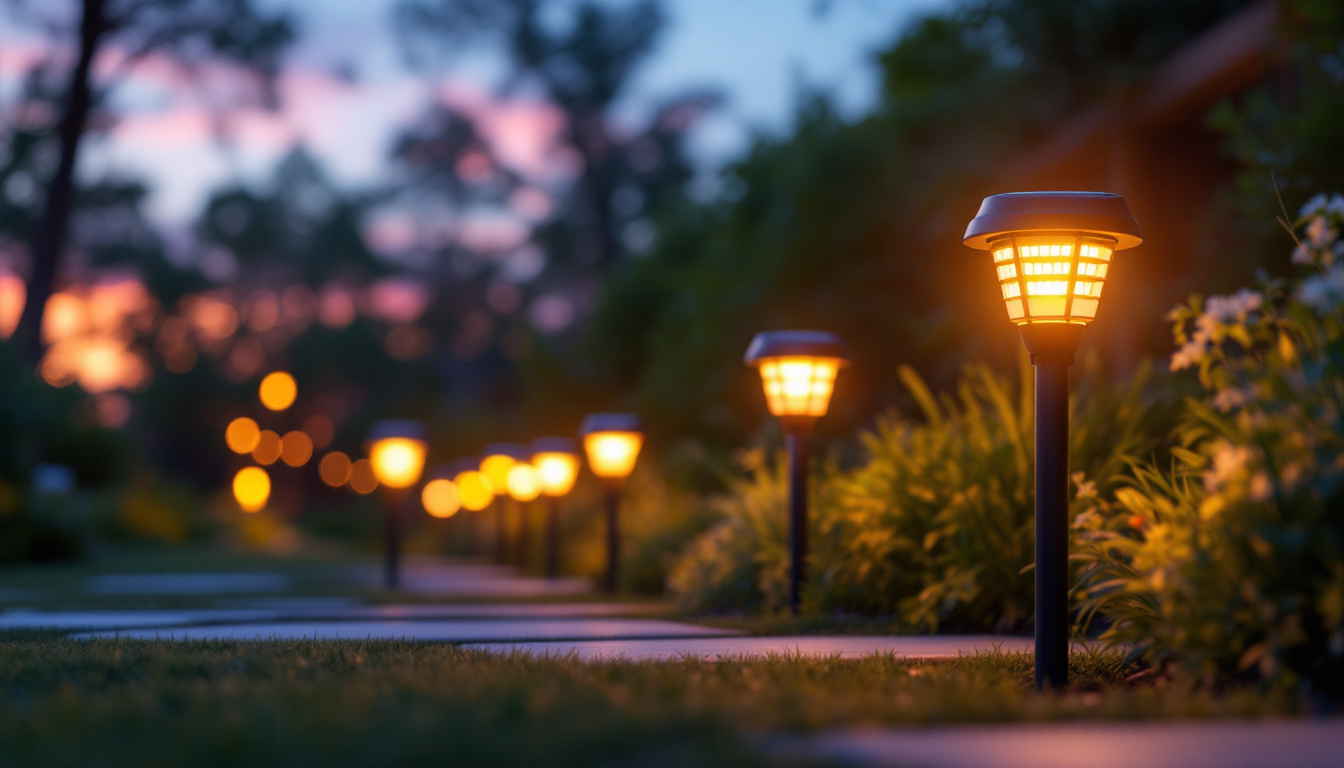
In recent years, solar landscaping lighting has emerged as a popular choice for homeowners and businesses alike. For lighting contractors, understanding the nuances of solar lighting technology is essential to meet client needs and expectations. This article delves into the critical aspects of solar landscaping lighting, offering insights and practical advice for lighting contractors.
Solar landscaping lights harness the power of the sun to illuminate outdoor spaces. They are equipped with photovoltaic cells that convert sunlight into electricity, storing it in batteries for use during the night. This technology not only reduces energy costs but also minimizes environmental impact, making it an attractive option for eco-conscious clients. The growing popularity of solar lighting has also led to advancements in design and functionality, allowing for a wider array of styles and features that can complement any landscape.
To effectively install and maintain solar landscaping lights, contractors must be familiar with the key components of these systems. The primary elements include solar panels, batteries, LED lights, and sensors. Each component plays a vital role in the overall functionality and efficiency of the lighting system. Understanding how these components interact can help in troubleshooting and optimizing performance, ensuring that the lighting system operates at peak efficiency.
Solar panels capture sunlight and convert it into electrical energy. The batteries store this energy, allowing the lights to function even when the sun isn’t shining. LED lights are favored for their energy efficiency and longevity, while sensors help automate the lighting system, turning lights on at dusk and off at dawn. Additionally, some advanced systems include motion sensors that can enhance security by activating lights when movement is detected, providing both safety and convenience for homeowners.
There are several types of solar landscaping lights available, each designed for specific applications. Path lights are commonly used to illuminate walkways and driveways, enhancing safety and aesthetics. Spotlights can highlight architectural features or landscape elements, while floodlights provide broader illumination for larger areas. The versatility of these lights allows for creative landscaping designs that can transform ordinary outdoor spaces into stunning nightscapes.
Additionally, decorative solar lights, such as string lights or lanterns, can create ambiance in outdoor spaces. These decorative options can be particularly effective for events or gatherings, adding a festive touch while remaining energy-efficient. Understanding the various types of solar lights allows contractors to recommend the best options based on the client’s needs and preferences. Moreover, with the advent of smart solar lighting technology, clients can now control their outdoor lighting through mobile apps, providing a modern solution to traditional landscaping challenges and enhancing user experience.
Solar landscaping lighting offers numerous benefits that can be highlighted to clients. The most significant advantage is the reduction in energy costs. Since solar lights operate independently of the electrical grid, homeowners can save on their electricity bills while enjoying well-lit outdoor areas. This not only provides financial savings but also contributes to a more sustainable lifestyle, as homeowners can reduce their carbon footprint by utilizing renewable energy sources.
Moreover, solar lights are relatively easy to install, as they do not require extensive wiring or electrical work. This simplicity can lead to lower labor costs and quicker project completion times. Additionally, solar lights are often more environmentally friendly, appealing to clients who prioritize sustainability. Many solar lighting options are designed with energy-efficient LED bulbs that consume less power and have longer lifespans compared to traditional lighting solutions, further enhancing their appeal.
Another appealing aspect of solar landscaping lights is their low maintenance requirements. Once installed, these systems generally require minimal upkeep. Regular cleaning of solar panels and occasional battery replacement are typically the only maintenance tasks needed. This ease of maintenance can be a selling point for contractors, as it reduces long-term commitments for clients. Furthermore, many modern solar lights come equipped with automatic sensors that turn the lights on at dusk and off at dawn, ensuring optimal performance without any manual intervention.
In addition to their low maintenance, solar landscaping lights can enhance the aesthetic appeal of outdoor spaces. With a variety of styles and designs available, homeowners can choose fixtures that complement their landscape and architectural features. From elegant pathway lights to whimsical garden stakes, solar lighting can create a warm and inviting atmosphere for evening gatherings or quiet nights under the stars. Moreover, the soft glow of solar lights can highlight landscaping features, such as trees, shrubs, and water features, adding depth and dimension to outdoor environments.
While solar landscaping lighting presents many advantages, there are also challenges that contractors should be aware of. One primary concern is the dependence on sunlight. In areas with limited sunlight or during prolonged cloudy periods, the performance of solar lights may be compromised.
Contractors must also consider the quality of solar products. Not all solar lights are created equal; lower-quality options may have shorter lifespans or inadequate brightness. It is essential to choose reputable manufacturers and educate clients about the importance of investing in high-quality products.
A thorough site assessment is crucial before installing solar landscaping lights. Factors such as the amount of sunlight the area receives, potential obstructions, and the desired lighting effect must be evaluated. This assessment will guide the selection of appropriate light types and placements, ensuring optimal performance and aesthetics.
Planning the layout is equally important. Contractors should consider the spacing between lights, the height of installations, and the overall design to create a cohesive look that meets the client’s vision. Proper planning can significantly enhance the effectiveness of the lighting system.
Successful installation of solar landscaping lights involves adhering to best practices that ensure functionality and longevity. First, it is essential to follow the manufacturer’s guidelines for installation, as each product may have specific requirements.
When placing solar lights, contractors should aim for locations that receive direct sunlight for the majority of the day. Avoiding shaded areas will maximize the efficiency of the solar panels, leading to brighter lights at night. Additionally, ensuring that the lights are securely anchored will prevent them from being easily knocked over or displaced.
After installation, testing the solar lights is a critical step. This process involves checking the brightness, ensuring the sensors function correctly, and confirming that the lights turn on and off as intended. Adjustments may be necessary to optimize performance, such as repositioning lights that are not receiving adequate sunlight.
Educating clients about solar landscaping lighting is vital for ensuring satisfaction and proper usage. Contractors should explain how the system works, including the importance of sunlight exposure and maintenance requirements. Providing clients with information on how to care for their solar lights can lead to longer-lasting systems and happier customers.
Clear communication is also essential throughout the project. Keeping clients informed about the installation process, potential challenges, and timelines fosters trust and transparency. This approach can lead to positive reviews and referrals, which are invaluable for growing a lighting contractor’s business.
Many clients may have misconceptions about solar landscaping lighting, such as concerns about brightness or reliability. Addressing these misconceptions head-on can help alleviate concerns. For example, explaining that modern solar lights use high-efficiency LEDs can demonstrate that they can provide adequate illumination.
Furthermore, discussing the advancements in battery technology and solar panel efficiency can reassure clients about the reliability of solar lighting systems. Providing examples of successful installations can also help build confidence in the technology.
The solar lighting industry is continuously evolving, with new technologies and trends emerging regularly. One notable trend is the integration of smart technology into solar lighting systems. Smart solar lights can be controlled via mobile apps, allowing users to adjust brightness, set timers, and monitor energy usage.
Another trend is the development of more aesthetically pleasing designs. Manufacturers are increasingly focusing on creating solar lights that blend seamlessly with outdoor decor, offering both functionality and visual appeal. This trend can attract clients who may have previously been hesitant about the appearance of solar lights.
As sustainability becomes a more significant concern for consumers, the demand for eco-friendly lighting solutions is likely to grow. Contractors can position themselves as leaders in sustainable practices by promoting solar landscaping lighting as a green alternative to traditional lighting options.
By emphasizing the environmental benefits of solar lighting, such as reduced carbon footprints and energy conservation, contractors can appeal to a broader audience and align their services with the values of eco-conscious clients.
Solar landscaping lighting presents a wealth of opportunities for lighting contractors. By understanding the technology, benefits, challenges, and best practices associated with solar lights, contractors can effectively meet client needs and enhance their service offerings. With the growing emphasis on sustainability and energy efficiency, investing time in mastering solar landscaping lighting can lead to increased client satisfaction and business growth.
As the industry evolves, staying informed about trends and advancements will be crucial for contractors looking to remain competitive. By embracing solar technology and educating clients, lighting contractors can position themselves at the forefront of this exciting and environmentally friendly lighting solution.
Ready to elevate your solar landscaping lighting offerings and give your clients the sustainable, high-quality solutions they deserve? Look no further than LumenWholesale. We provide lighting contractors with an exceptional range of spec-grade lighting products at unbeatable wholesale prices. Our commitment to quality and affordability means you can access the best solar lighting options without the burden of inflated markups. Plus, with free shipping on bulk orders, you can stock up on premium lighting essentials while keeping your costs down. Don’t let hidden fees or limited selections hold you back. Discover the perfect combination of quality, value, and convenience at Wholesale Lighting at the Best Value and make your next project shine with LumenWholesale.

Discover how magnetic LED light strips are revolutionizing modern lighting solutions with their versatility, energy efficiency, and easy installation.

Discover effective strategies for training your team on ballast compatible LED tubes in this insightful guide.

Explore the transformative journey of solar battery lights in the lighting industry, highlighting their eco-friendly innovation, cost-effectiveness, and impact on sustainable living.

Discover essential tips and strategies for lighting contractors to excel in strip lighting projects.